In the Soviet Union of the early 1950s, cybernetics was derided as an American and bourgeois “reactionary pseudoscience”. It is only after the death of Stalin that scientists and engineers started to celebrate the “computational objectivity” of cybernetics. In 1961, the Communist Party of the Soviet Union even went as far as to declare the field one the “major tools of the creation of a communist society”. By the 1980s, however, cybernetics had lost relevance in Soviet scientific culture, its terminology and political function being slowly replaced by those of informatics.
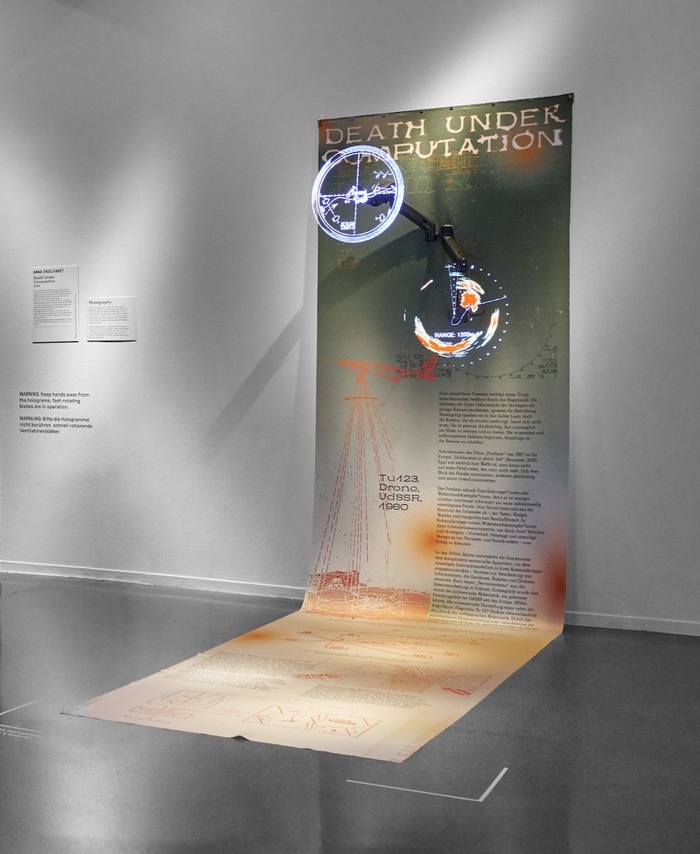
Anna Engelhardt, Death Under Computation, 2022, in the exhibition House of Mirrors: Artificial Intelligence as Phantasm, HMKV at Dortmunder U, 9 April 2022 – 31 July 2022. Photo: Mareike Tocha
In her multi-media work Death Under Computation, Anna Engelhardt traces how today’s Russian drones and other ‘smart weapons’ have their roots in largely-unknown experiments of Soviet military cybernetic research from the 1950s. Her project is articulated around a website and a series of material objects. The website explores the colonial logic at work in contemporary Russian warfare. Its physical counterpart translates the research detailed on the website into holograms and textile diagrams.
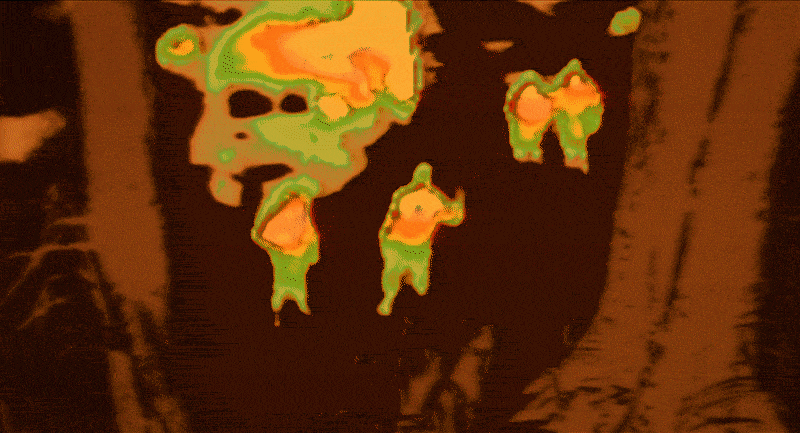
Excerpt from Predator (1987) edited by Anna Engelhardt for the project website
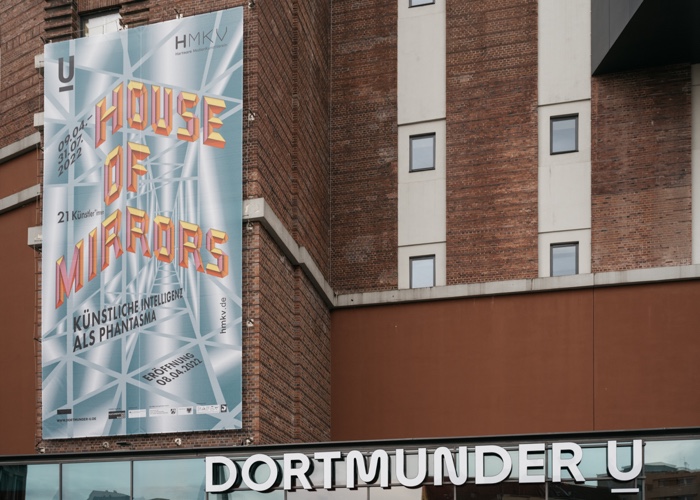
Opening of House of Mirrors: Artificial Intelligence as Phantasm at HMKV in Dortmund. Photo: Daniel Sadrowski
Long before the war in Ukraine, Engelhardt was criticising the brutal imperialist expansion of Russia. Her work attempts to demonstrate that understanding its colonial premise can make emerge new ways of resistance to state disinformation and surveillance. As such, Death Under Computation is intended to help researchers and activists comprehend the deeper systems at play in contemporary Russian warfare.
Death Under Computation was exhibited last Summer at HMKV in Dortmund as part of House of Mirrors: Artificial Intelligence as Phantasm, an exhibition that “takes the common clichés about AI as an opportunity to talk about issues such as hidden human labor, algorithmic bias/discrimination, the problem of categorization and classification, and our fantasies about AI. It asks whether (and how) it is possible for us to reclaim agency in this context.” I couldn’t visit the show but I still managed to get in touch with Anna Engelhardt for an interview:
Hi Anna! What prompted your interest in Soviet military cybernetic research in the 1950s?
My research deals a lot with military technologies and what we consider high-tech today. During the research phase of the project, I realised that many military systems that would now be classified or considered secret emerge from a history that is available to the broader audience. It turns out that their functionality hasn’t changed drastically over time. The way those weapons function can improve or evolve, but it is essentially built on the same premise or the same logic. So I looked at history to try and understand how exactly those military technologies and systems developed decades ago still function today. I wanted to research a phenomenon that is very difficult to access, especially in a country like Russia. Warfare researchers fill in Freedom of Information requests in countries like the USA. In Russia, because of the non-democratic nature of the government, it is tough to get access to that kind of information. Therefore, the less classified history of technology could be a productive entry point to research contemporary military developments.
Simultaneously, I was particularly interested in cybernetics as a subject and its overshadowed military history, following After Scarcity by Bahar Noorizadeh and Oleksiy Radynski‘s Is Data the New Gas?. For anyone who might not know a lot about Soviet cybernetics, it was a strand of research in the Soviet Union that aimed to develop various self-regulating systems concerning the economy, distribution of resources, etc. Cybernetics was the hardware and software that could allow centralised planning to redistribute resources more efficiently. Initially, it was prohibited by the Soviet State in the early 1950s, but only as a civilian science. Military cybernetics at that time was one of the USSR’s leading strands of military science. This period of military cybernetics in particular and military cybernetics as a broader science has been kept an open secret until now.
What defined my interest was thus this combination of two factors: on the one hand, the overshadowed history of Soviet military cybernetics and, on the other hand, the valuable entry point into classified contemporary weapons.
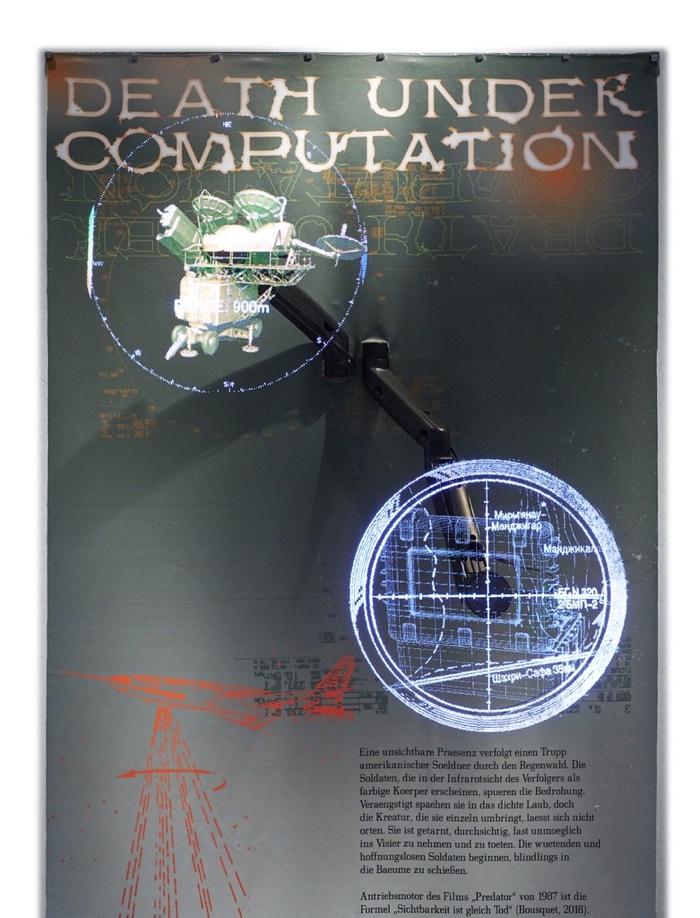
Anna Engelhardt, Death Under Computation, 2022, in the exhibition House of Mirrors: Artificial Intelligence as Phantasm, HMKV at Dortmunder U, 9 April 2022 – 31 July 2022. Photo: Mareike Tocha
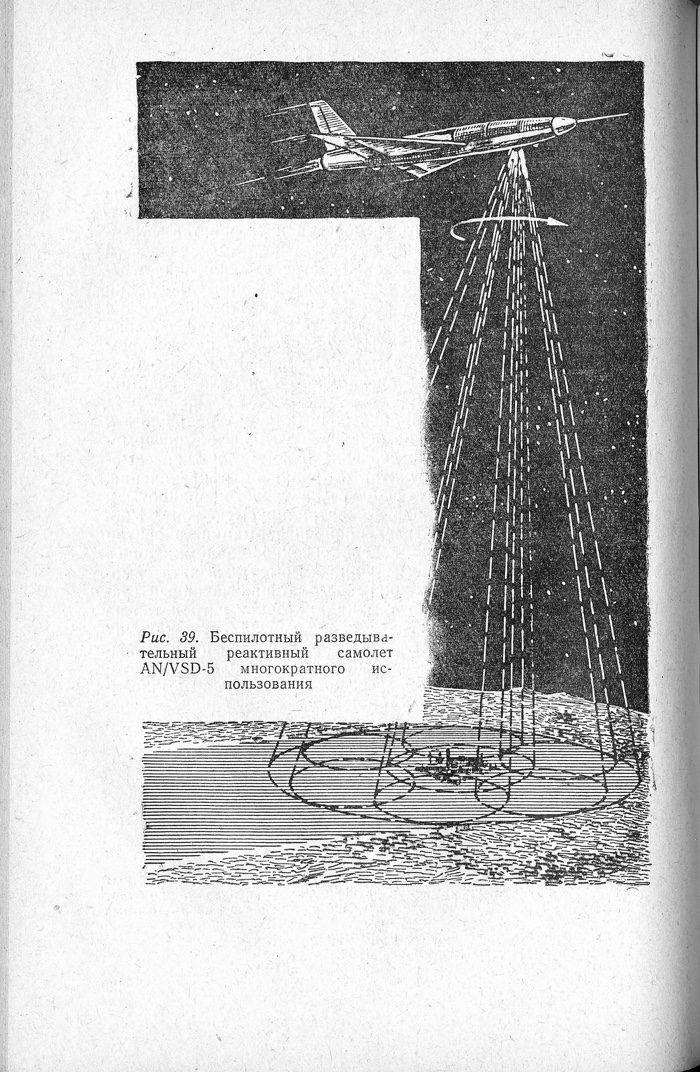
Diagram from Cybernetics in Military Affairs (1963) Goncharenko, M. N. 1963. Moscow, DOSAAF (Volunteer Society for Cooperation with the Army, Aviation, Navy)
As you explained, the experiments made for the 1950s Soviet military cybernetic research are not widely known. How did you research the topic? You’ve mentioned art, but where else did you find information?
It’s been a complicated source-finding adventure, partly because archives in Russia are not very open to the public. Still, many books you would generally find in archives, such as student books for Soviet engineers and other scientists, can be found in second-hand bookshops. I would research what was available in libraries and then look for those sources in second-hand bookshops to buy and scan them. For instance, the visuals that made it into the textile of the installation are all based on old books about cybernetics that I got from a second-hand antique bookshop. These sources are invaluable. Because they are aimed at specialist audiences, they have to be more honest about the nature of those technologies, compared, for example, to public-facing ideological texts. They are also important because I wanted to learn about technologies I would know very little about. For instance, I didn’t realise how advanced drone research was in the Soviet Union! Drone research was already happening in the 1950s, and the USSR has used drones for surveillance since the 1960s.
I also spent a lot of time on forums or listening to Russian soldiers who participated in wars such as the war in Afghanistan. Sometimes they would directly say something worthwhile. Sometimes, you could infer from their accounts the particularities of how those technologies were being used. As is often the case, the way a military computer or sensor is supposed to be used and the way it is actually used on the ground are two very different things. Many Russian soldiers hate smart weapons and consider them unreliable, so they often complain about them in their accounts or recall how they glitch and run out of battery.
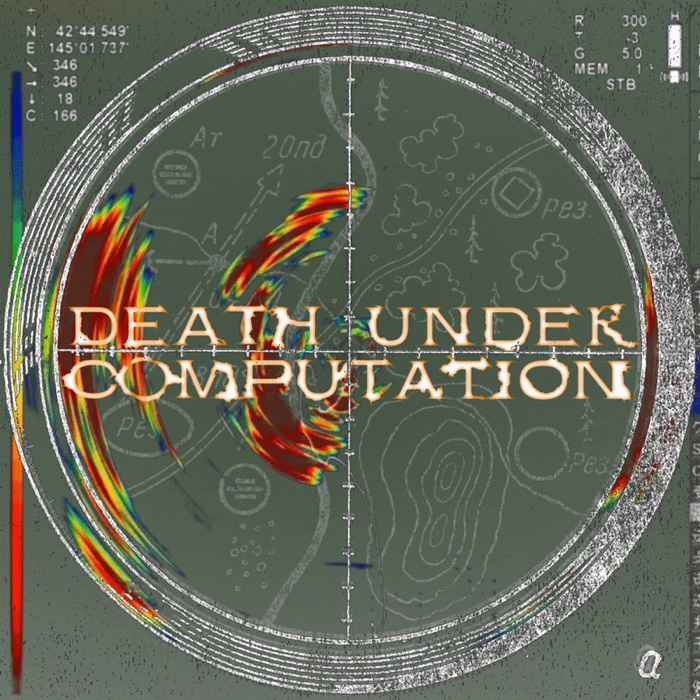
Anna Engelhardt, Death Under Computation, 2022
What you’ve just said about pioneering drone research in the Soviet Union is very interesting because a lot of what I know about technology comes from US or British sources. I had stupidly assumed that the Americans and the Brits had pretty much invented everything related to technology. It was only when I started listening to French radio shows about technology that I realised (or was reminded) that actually much of technology has also been pioneered and invented outside of the “Anglo-Saxon” sphere. It’s just not being acknowledged in English-speaking media.
Military technologies are never developed in a vacuum. Even in the Cold War era, the leading scientists in Russia and the US were learning from each other. Russian military cybernetic thinker Nikolay Ogarkov later informed the Revolution in Military Affairs in the US in the 1970s and became one of the core references for American military thinkers. Moreover, he was later forgotten in the history of the Soviet Union but is still considered a crucial figure in the history of the US military.
It is interesting to see how supposedly opposing countries and political powers constantly collaborate on projects that advance violence instead of actually confronting one another. If we look closely at the history of these projects, we can see that what we imagine as competing empires, in reality, tend to work together towards the same goal. It creates an interesting perspective on contemporary politics and on people dismissing the Russian invasion of Ukraine by blaming NATO or the US for it. As if the US were genuinely competing with Russia.
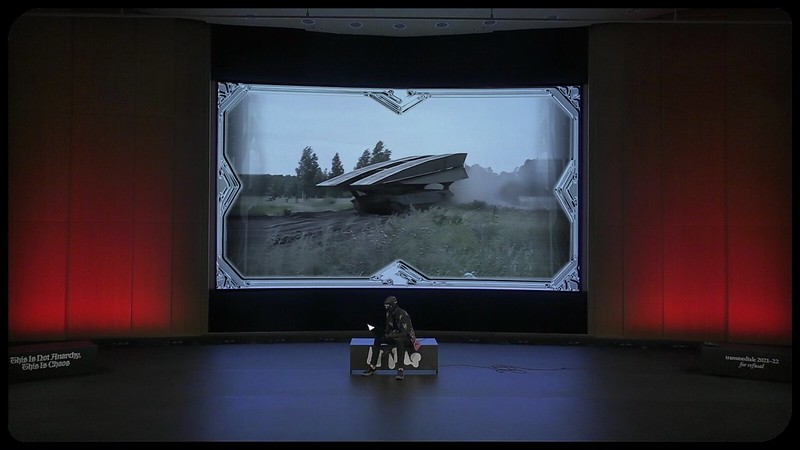
Anna Engelhardt delivering lecture-performance on the technology of Russian colonial invasions, given at Transmediale 2022, Haus der Kulturen der Welt (HKW), Berlin
Your PhD looks at Russian cyber warfare as a colonial enterprise. Could you tell us a few words about what you found out? In terms of geographical distribution, how far does this colonial enterprise extend? Is it mostly about -as we can read in European newspapers- getting back the territories that once formed the Soviet Union?
The Russian colonialism at the core of my research helps to understand contemporary Russian ongoing invasion and genocidal violence against Ukraine. The Russian colonial mindset behind this invasion is very similar to the one guiding the Russian Empire when it tried to bring down the Ukrainian people 200, 300 years ago. This is why researching Soviet military cybernetics is relevant for contemporary smart weapons because the logic of the invasion persists even though Russia is not the Soviet Union anymore. As long as the rationale stays the same, the goals and principles of those technologies remain intact. Some of us might use the internet as opposed to the radio. Still, the way colonial invasions will try to weaponise and leverage those means of communication will be very similar to what it was in the past. That is why it is essential to look into the history of those technologies -particularly cyberwar- in light of the current bombardment of misinformation coming from Russia. Misinformation as a strategy existed long before the internet. In the 20th century, misinformation spread through the radio by jamming and hacking other broadcasts to transmit malicious information, fake news of that time. Misinformation on the radio is actually still present! Even though for many Ukrainian cities, there is still electricity and internet connection, Russian bombardments in Syria brought about electricity blackouts and forced radio back into use. It is crucial to keep in mind when discussing the unprecedented spread of Russian misinformation today that it has happened before and that we should look at how people have been dealing with it and countering it. Those elements remain even though technologies change. Colonialism remains a kind of meta-structure.

Excerpt from Predator (1987) edited by Anna Engelhardt for the project website
How did Soviet cybernetic research provide the groundwork for contemporary Russian ‘smart weapons’? Was there really a continuity in the research despite the political disturbances that took place over the past few decades?
As I mentioned before, the colonial rationale is the same. Even though the project is now capitalist and not communist anymore, the core ideology of Russia hasn’t changed much. It is still colonialism.
With Death Under Computation, I wanted to highlight how those colonial objectives inform smart weapons and other technologies. The narrative of my work starts with the scene from the film Predator. The film suggests a hidden presence that tracks American soldiers in the rainforest. We watch the scene from the perspective of a racialised guerrilla warrior, presented as an alien, who follows the movements of troops in the forest. Since American soldiers cannot see him and he can see their every detail in infrared vision, he has a monopoly on information. I used the movie to introduce the audience to the idea that knowledge is critical in colonial warfare. The ‘Predator’ is an obvious allusion to the US invasion of Vietnam. Empires have deep anxiety about the people they aim to colonise since they know the environment better than the colonisers. In the film, one can see ‘Predator’ so well hidden in the forest that the colonial soldiers see it as a part of the forest. To overcome such an imbalance of information, empires try to become more technologically advanced. They prioritise acquiring and processing data in military technologies. This is how colonial logic gets hardwired into its weapons.
In my research, I looked at early cybernetic research, which was essentially about sensors and the best ways to automate the sensorium of the battlefield, following the logic I have just explained. It was a strategy – and here we can think again about the Predator movie- to counter this invisible resistance fighter with complicated machines that would distribute eyes, brains and ears around the battlefields and make it fully transparent. That was essentially an impossible task. Those weapons were trying to find targets in space, but that was an inefficient goal.
Because this view on anti-colonial resistance hasn’t changed, it still informs how new technologies are being engineered. In the 1990s, for example, when the USSR was dissolved, the smart weapons used in Afghanistan were used again in the invasion of Chechnya. After the war in Chechnya, there was a reform. Existing devices were refined and advanced, not discontinued. The military uses the same line of hardware that has been there for 50 years. That’s why I talk about a continuation.
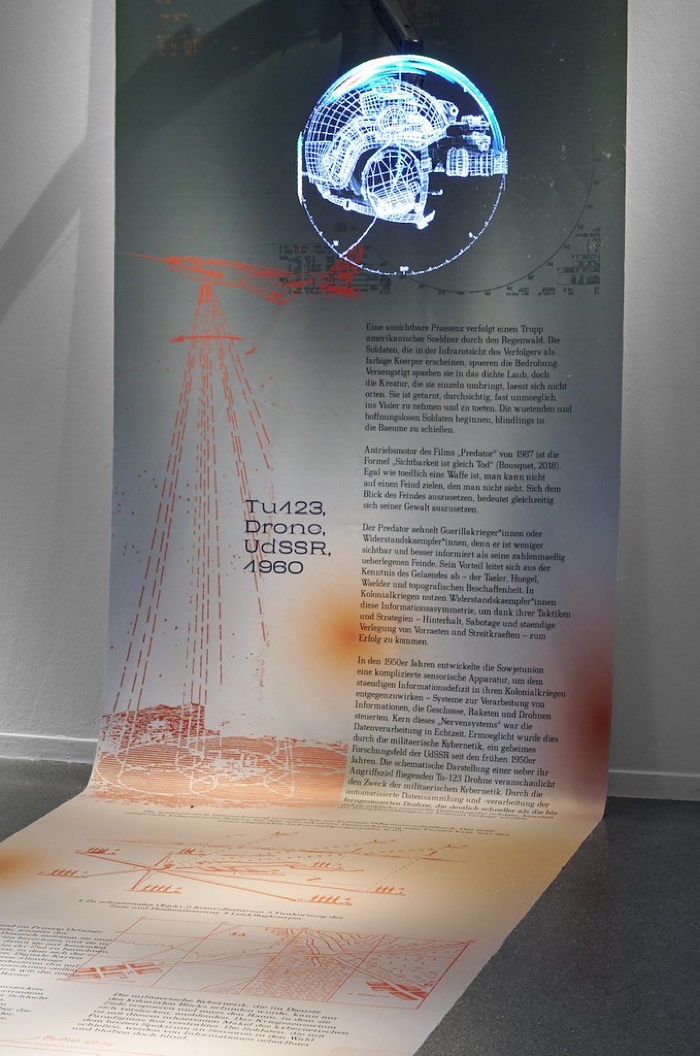
Anna Engelhardt, Death Under Computation, 2022, in the exhibition House of Mirrors: Artificial Intelligence as Phantasm, HMKV at Dortmunder U, 9 April 2022 – 31 July 2022. Photo: Mareike Tocha
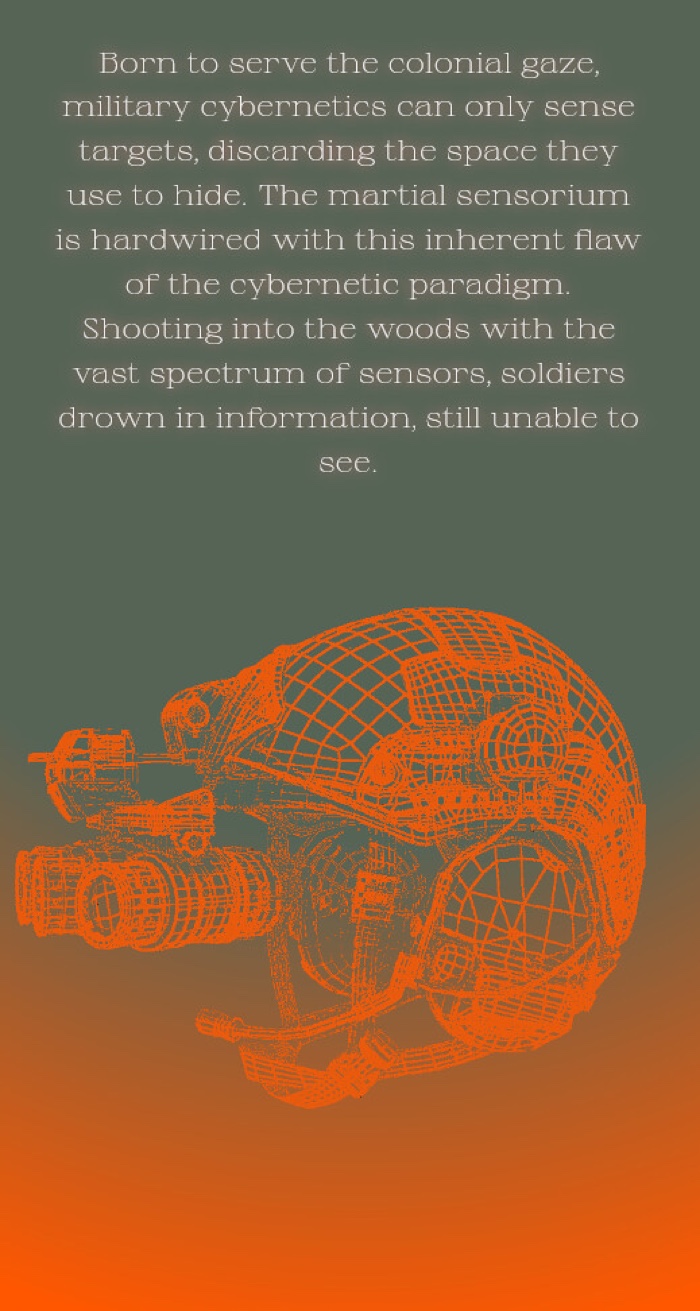
Screenshot from the mobile version of Death Under Computation website
Could you tell us what guided your choices regarding the form, media and aesthetics of Death Under Computation? I’m particularly interested in knowing more about the textile diagram, as textile is not the most obvious material when exploring contemporary technology.
My interest in textiles and holograms comes from the main media I work with: websites. I am particularly interested in working with websites since they allow for a flexible narrative of the artwork, which would be accessible and interactive. Trying to think through the way a website could be presented in an analogue format, I drew upon visions of cyberspace as a fabric. Textile evokes a spatial metaphor in the way you scroll through the website. Simultaneously, the moving image aspect of my websites, usually centred around CGI objects that I make myself, is translated into holograms. Some of the holographic graphics I manufacture myself. Others I found while researching archives.
Working with moving images allows me to create deeper associations and suggest links within familiar visual language that might not have been made before. In the project Death Under Computation, I used the notion of the “hollow space”, referring to how space is represented in cybernetic machine vision. What was interesting for me was how the holograms themselves create a hollow space in the air, allowing them to visualise the gaps in the map. I hope that the hologram made this allegory of the hollow space clear to the viewer as a visual metaphor, not just an abstract concept. In the visual narrative of the holograms, I used maps overlaid with different generations of sensing interfaces to try and make connections between earlier technologies of mapping and contemporary technologies that use ultrasonic or infrasonic or radar engineering that automatically map their surroundings. In that way, I aimed to make a fully autonomous version of the website in HMKV. Simultaneously, a person could visit the website and experience the work online without the need to be in Dortmund physically.
Let’s now look at what you were showing at HMKV as part of the House of Mirrors: Artificial Intelligence as Phantasm exhibition. One of the questions asked by the show was whether (and how) it is possible for us to reclaim agency when there is so much misunderstanding about AI and what it can do. How does Death Under Computation look into this question? How does it suggest that we can regain agency?
Agency was one of the core aspects of the work. Those technologies, from the AI and surveillance aspects, try to create the belief that we do not have any agency, that we have to accept that we are fully surveilled and that there is no way to escape that. We are presented with a “fact” of total surveillance, but my work tries to question that narrative and create a suspicion that these technologies might be dysfunctional. Because I’m an artist and not an engineer, I primarily work with speculation and information. Therefore, for me, this kind of agency means being informed, knowing that something is possible, imagining that weapons can be dysfunctional or that the military apparatus is not as powerful as it wants to appear. I see the agency lying in deconstructing the narrative of the undefeatable war machine and showing that it has bugs and inefficiencies, just like other technologies. I hope the work communicates this way of thinking to the viewer of the artwork.
What is next for you? Are there any upcoming exhibitions, research or projects you are working on?
I’m currently in a residency with transmediale working with Belarusian scholar and artist Mark Cinkevich on a new project for the festival. This CGI essay film explores the horror of Russian colonialism through the process of possession – the gradual imposition of control on an organism that leads to its destruction from within. We aim to uncover the largely unknown life cycle of Russian colonial military bases, following their first signs of deployment to their later devastation and consumption of foreign countries. Our extensive research into current Russian military bases yielded a critical insight – these structures are enmeshed with existing energy networks. In effect, electricity animates occupation. The film will locate the viewer within an unsettling CGI environment, reconstructed from satellite images of the air bases of Khmeimim in Syria, Baranovich in Belarus, and Saky in Ukraine. By visualising the bases’ energy consumption and infrastructure over time, the film uses electricity to show the dependence of the possessing force on its host.
Thanks Anna!
